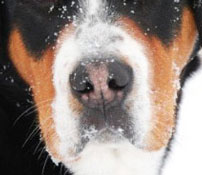Last week I noticed that the end of Saffron’s nose looked lighter.  It’s normally black, but there was this lighter, pinker area in the middle.  Being a worrier, I started researching it and it turns out it’s something called Snow Nose or Winter Nose.  I went looking for a clear explanation of Snow Nose, but was unable to find an authoritative source.  So I started looking for a good explanation of melanogenisis (the production of melanin or pigment in tissue.)  But to understand that, I needed to understand tyrosinase (an enzyme that regulates melanogenisis).  Guess what I learned?!  Melanogenisis and tyrosinase is some seriously complicated shit! (Be sure to scroll & scroll & scroll down if you want to learn more.)
So what’s the skinny on Snow Nose?  It’s a harmless, seasonal lightening of the pigmentation of the rhinarium in dogs. (The rhinarium is the moist, hairless part at the end of a dog’s snout.)  Pigmentation is increased with exposure to ultraviolet light, increased temperatures, and friction, so the short cold days of winter cause the pigment to fade, but when summer comes, the longer days and warmer temperatures cause the pigment to darken again.
If your dog’s nose doesn’t darken again in the summer, visit your vet to see if anything is amiss. Â And there are other reasons a dog’s nose color can change, so if your dog’s nose loses all it’s pigment, has any crust or scabs, looks like it itches or hurts, or has any swelling, get your pup checked out by a vet.


